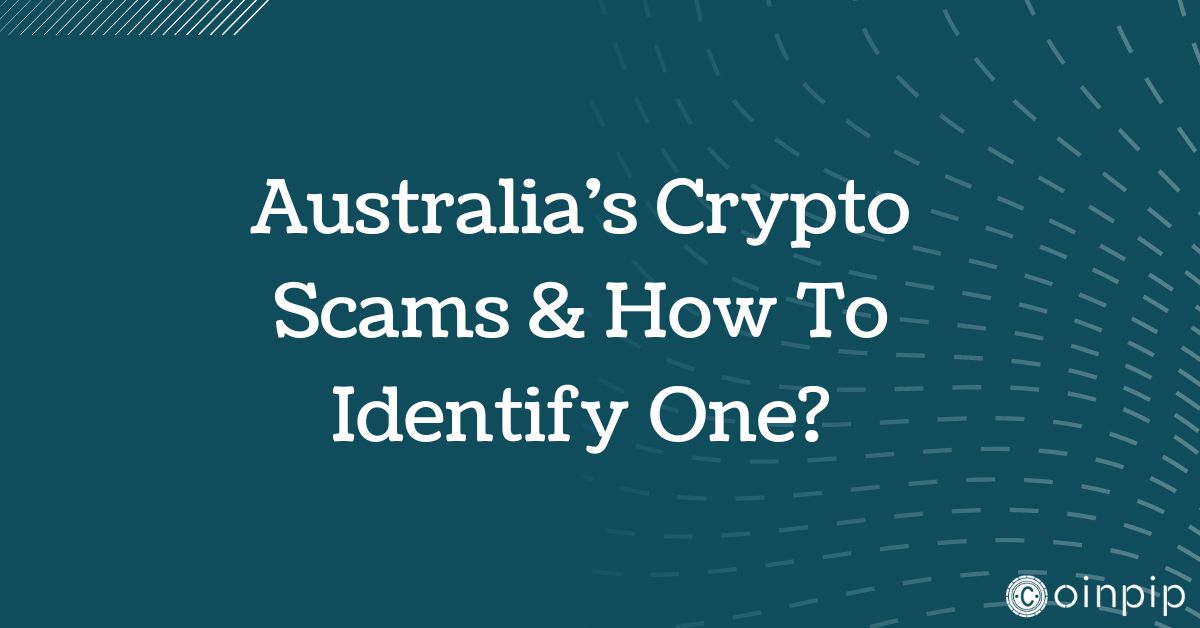Australia’s Crypto Scams & How To Identify One In 2025
As cryptocurrencies gain popularity in Australia, the allure of digital assets has drawn in both legitimate investors and unscrupulous actors.
The innovation and potential for high returns associated with cryptocurrencies such as Bitcoin, Ethereum, and various altcoins have captured your attention.
Alongside this growing interest, however, there’s been a surge in crypto scams, with Australians bearing the brunt of sophisticated fraudulent schemes.
Understanding these scams is crucial to protecting your investments as you navigate this emerging financial landscape.
Crypto scams in Australia have manifested in various forms, exploiting vulnerabilities ranging from a lack of understanding to the inherent anonymity of transactions.
You might encounter anything from investment schemes that promise astronomical returns to tokens that appear in your wallet without prior action, often tied to deceptive contracts that can threaten your digital assets.
Recent data has shown a shocking increase in the money Australians have lost to scams, emphasizing the need for vigilance and a thorough vetting process before you make any crypto-related transactions.
Common Types of Crypto Scams in Australia
Cryptocurrency scams in Australia exploit a range of tactics to deceive you. Familiarize yourself with the common types to enhance your vigilance in the digital finance landscape.
#1. Phishing Scams

Phishing scams are fraud attempts where scammers impersonate legitimate organizations via email or messaging services. Be cautious of unsolicited communications that prompt you to share sensitive information such as wallet keys or passwords.
#2. Romance Scams

In romance scams, perpetrators form a fake romantic relationship with you and eventually ask for cryptocurrency, preying on your emotional vulnerability. Always be wary about sending funds to someone you have only met online.
#3. Fake QR Codes

Fake QR Codes, also known as quishing, can trick you into scanning malicious codes that redirect to counterfeit websites. Never scan QR codes from untrusted sources, as they may compromise your personal and financial information.
#4. Employment Scams
Scammers may present you with fraudulent job offers that ask for cryptocurrency payments for training or work-from-home setups. Legitimate employers will never ask for payments in the recruitment process.
#5. Flash Loan Attacks

Flash loan attacks involve using crypto borrowing systems to manipulate market prices. These scams can dramatically affect market stability and your investments.
It’s crucial to stay informed about the security measures of your chosen lending platforms.
Prevalence and Impact
Cryptocurrency scams have notably impacted Australians, with financial losses exceeding $221 million in a recent year.
The magnitude of these scams is significant, illustrating how they have evolved into a pressing financial concern. Within the broad spectrum of fraudulent activities, crypto scams rank highly as contributing to financial deception.
Financial year statistics reveal that in 2022 alone, Australians were defrauded of a staggering $3.1 billion across all types of scams, with a substantial portion of this figure being attributed to cryptocurrency scams.
This marks an urgent call for heightened vigilance and the deployment of effective preventative measures.
You need to be aware that the number of reported crypto scams has surged, underlining the allure of digital currencies to both legitimate investors and opportunistic scammers.
Given the decentralized nature of cryptocurrencies, recovering lost funds can be particularly challenging, exacerbating the impact of these scams.
To safeguard your financial well-being, stay informed about the prevailing tactics used by scammers.
Recognize that the impact of these deceptive practices extends beyond immediate monetary losses, affecting your confidence in digital investments.
Being aware of the risks and taking proactive steps to protect yourself is indispensable in navigating the complex landscape of cryptocurrency investments.
Preventive Measures and Security Tips
When participating in cryptocurrency, vigilance is your best defense against scams. Use these security practices to safeguard your digital assets:
Recognize Common Scams
- Check URLs Carefully: Ensure you are visiting legitimate and secure sites. Look for ‘https://’ and avoid sites with misspelled domain names.
- Unsolicited Offers: Be wary of investment opportunities that come out of the blue, particularly those promising high returns with low risk.
Safeguard Your Information
- Private Keys: Keep the keys to your cryptocurrency wallets private. Never share them, as they provide direct access to your funds.
- Sensitive Account Details: Protect your account information and be cautious about whom you share access credentials with.
Implement Security Software
- Antivirus Software: Equip your devices with the latest antivirus software to detect and counteract malicious software.
- Digital Communications: Exercise caution when dealing with unsolicited emails or messages. Verify the sender’s identity before clicking on links or downloading attachments.
Stay Informed
- Follow updates from trusted sources such as the Australian Securities and Investments Commission (ASIC) or the Australian Competition & Consumer Commission (ACCC) to stay aware of current threats.
Adopting these measures can significantly reduce your risk of falling victim to cryptocurrency scams. Stay informed, stay skeptical, and always prioritize the security of your digital assets.
How to Spot a Crypto Scam
Recently, cryptocurrency scams have surged, leading to significant financial losses. Educating yourself on common scam indicators is vital in safeguarding your assets. Here are key signs to help you identify a potential crypto scam:
- Unsolicited Offers: Be wary if you receive unexpected contact offering investment opportunities in crypto, especially if high returns are promised with little to no risk.
- Pressure Tactics: Scammers often create a sense of urgency to push you into making quick decisions without proper research or due diligence.
- Anonymity: If the party is reluctant to provide verifiable contact information or their identity remains obscured, this raises a red flag.
- Guaranteed Returns: The promise of guaranteed profits is deceptive, as the value of cryptocurrencies is volatile and cannot be predicted with certainty.
- Complex Jargon: Overuse of complex technical language may be intended to confuse or intimidate you into investing without understanding.
- Unregistered Exchanges: Verify that a digital currency exchange is registered with relevant regulatory bodies, such as AUSTRAC in Australia.
The role of education cannot be overstated when it comes to preventing crypto scams. Understanding how cryptocurrency works and what legitimate investments look like will equip you to steer clear of fraud. Remember:
- Conduct thorough research.
- Verify information from multiple sources.
- Trust instincts—if something seems too good to be true, it likely is.
Government and Institutional Responses
The Australian government has taken assertive steps to address the spike in cryptocurrency scams.
Your protection against these fraudulent activities is a priority, leading to the establishment of the National Anti-Scam Centre.
Under this initiative, you can expect a consolidated effort to track and respond to scam operations.
Regulatory Updates
- Mandatory Industry Codes: Financial institutions must now adhere to codes developed to safeguard their investments in digital assets.
- Legislative Revisions: The government has proposed changes targeted at digital currency exchange providers to increase transparency and security for your transactions.
Australian Securities & Investments Commission (ASIC):
- Penalties for Misconduct: ASIC has increased fines and penalties for companies that mislead or deceive investors, reinforcing your consumer rights.
- Educational Campaigns: To arm you with the information needed to identify scams, ASIC regularly updates its guidelines on what to watch for.
Institutional Support
Banks and financial entities have ramped up their customer support to provide you with tools and resources to recognize and report scams.
Customer Service Initiatives:
- Real-time Alerts: You can now receive immediate notifications regarding suspicious activities on your accounts.
- Help Hotlines: Dedicated helplines are available should you need assistance or suspect you’re a scam victim.
The government and financial institutions are committed to providing a robust framework to counteract crypto scams and protect your interests. Stay informed, and do not hesitate to use available resources for any concerns or inquiries about cryptocurrency investments.
Case Studies of Crypto Scams in Australia
The Fake Exchange Trick:
You might have heard about the tale of a seemingly legitimate Australian crypto exchange that became a front for scammers.
Unsuspecting investors were lured with promises of easy profits and a user-friendly platform, only to discover that their funds disappeared overnight. An investigation revealed that the exchange was never registered and lacked the appropriate financial licenses.
- Method: Setup of a fraudulent exchange
- Target: New investors
- Outcome: Loss of all invested funds
The Celebrity Endorsement Hoax:
Another common tactic is the use of celebrity endorsements. Scammers create fake ads or social media posts claiming a public figure supports a specific cryptocurrency.
You believe you’re capitalizing on a VIP-endorsed opportunity by investing. Sadly, after the money is transferred, the illusion and the funds vanish.
- Method: Fake celebrity endorsements
- Target: Fans and followers
- Outcome: Misled investments
The Phishing Scheme:
In a more direct approach, your trust is exploited through malicious emails or messages. These scams involve links that direct you to counterfeit websites where you’re prompted to provide your private keys or login details.
Once the scammers have this information, they drain your crypto wallets.
- Method: Solicitation of sensitive information
- Target: Individual wallet holders
- Outcome: Compromised wallets and stolen assets
The Pump-and-Dump Setup:
Lastly, you might be drawn into a pump-and-dump scheme. Here, a small group artificially inflates the value of a little-known cryptocurrency, convincing others to invest heavily.
As soon as the price peaks, they sell off their shares, causing the value to plummet and leaving other investors with worthless assets.
- Method: Market manipulation
- Target: Unsuspecting traders
- Outcome: Inflated then crashed asset values
In each instance, scammers leverage your hopes for financial gain, harnessing sophisticated social engineering and digital tactics to commit fraud. Remember, vigilance and knowledge are your best defenses against these illicit activities.
The Impact of Crypto Scams in Australia
You’ve witnessed a significant rise in cryptocurrency scams in Australia with substantial financial repercussions.
Investment scams, where crypto is the vehicle of choice, have accounted for the most significant monetary losses. Australians have lost over $700 million to such scams in the last year.
Financial Losses by Australians in Crypto Scams
| Year | Estimated Losses |
|---|---|
| Last year | > $700 million |
| 2022 | $148 million |
You should be aware that these figures likely underrepresent the true extent of losses, as not all scams are reported.
The Australian Competition and Consumer Commission has noted that cryptocurrency-related scams’ reported losses were well over $100 million, indicating the gravity of the situation.
Beyond the economic impact, these scams have influenced how cryptocurrencies are perceived in Australia.
Due to the prevalence of scams, there’s a growing skepticism and wariness among the public and authorities regarding the security and reliability of crypto investments.
Perceptual Impact on Cryptocurrency
- Heightened skepticism toward cryptocurrency legitimacy
- Increased public wariness of crypto investments
- Regulatory Bodies’ Concerns over a consumer protection
Your understanding of these scams’ economic and societal impact should underline the need for caution when engaging with cryptocurrency and highlight the importance of robust measures to protect against such fraudulent activities.
Frequently Asked Questions
Cryptocurrency scams can be complex and challenging, but knowing how to navigate these situations is essential for protection and recourse. Below are some common queries with clear, actionable answers.
What are the steps for reporting cryptocurrency fraud in Australia?
If you suspect you’re a victim of a cryptocurrency scam in Australia, report it immediately to the Australian Securities and Investments Commission (ASIC) via their website.
You should also submit a report to the Australian Competition and Consumer Commission (ACCC) through the Scamwatch website.
Remember to collect and preserve any evidence related to the scam, such as emails, transaction IDs, and wallet addresses.
Can you get your money back if you get scammed in Australia?
Recovering funds lost to a cryptocurrency scam can be difficult, but there are avenues to try. Report the fraud as detailed above and promptly contact your bank or financial institution.
They can advise on the possibility of reversing the transaction. The recovery of assets depends on the scam’s specific circumstances and the scammers’ actions.
What were the most significant cryptocurrency scams in recent years?
Recent notable cryptocurrency scams include cases like the arrest and sentencing of a 25-year-old in Australia for stealing over 100,000 Ripple (XRP) tokens.
Another significant event was a 166% increase in losses to cryptocurrency scams in Australia from January to May 2022, underscoring the growing threat of these fraudulent activities.
What precautions should be taken to invest safely in cryptocurrency?
To safeguard your investments, perform diligent research on any cryptocurrency before investing.
Verify that any digital currency exchange is registered with the Australian Transaction Reports and Analysis Centre (AUSTRAC) and check for their registration number.
Be wary of unsolicited offers and too-good-to-be-true returns. Use two-factor authentication, employ strong passwords, and regularly monitor your investments for any signs of unauthorized activity.
Conclusion
Recent reports indicate a significant rise in crypto scams in Australia, with Australians losing large sums of money.
These fraudulent activities have capitalized on the decentralized nature of cryptocurrency, exploiting the lack of understanding among users.
Despite the efforts of Australian authorities, the sophistication of these scams continues to evolve.
Awareness and prevention are critical strategies in combating these scams. It would be best to remain vigilant and informed about common tactics fraudsters use, such as Ponzi schemes promising high returns. Always research thoroughly before investing.
Moving forward, the implementation of more robust regulations and the education of potential investors is vital.
By ensuring a safer environment for digital currencies and enhancing the public’s knowledge on managing and identifying risks associated with crypto investments, the likelihood of falling victim to such scams can decrease.
Your role in maintaining the integrity of your investments involves being cautious and staying updated with the latest security practices.
Remember, it likely is if an opportunity appears too good to be true. Italic_Remember to safeguard your digital assets by using reputable crypto exchanges like Bybit or BingX and wallets. Italic
As the digital finance landscape evolves, remain proactive and support initiatives to reinforce the cryptocurrency ecosystem against scams.
Together, Australians can achieve a more secure future in the crypto space through collective effort and informed actions.







